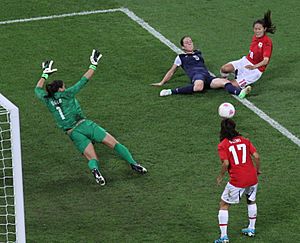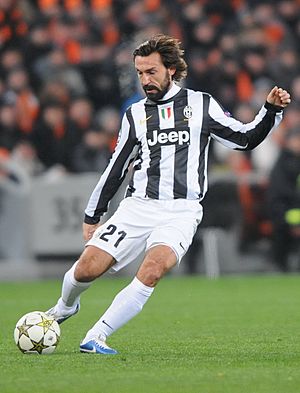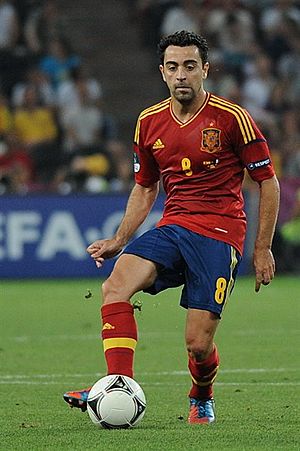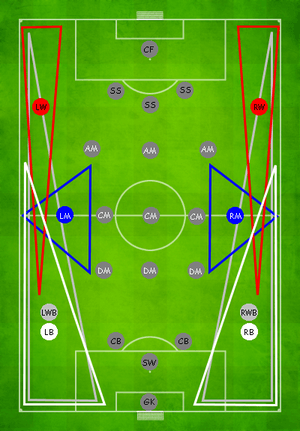Midfielder facts for kids
A midfielder is a football player who usually plays in the middle of the field. They are positioned between their team's defenders (who protect the goal) and forwards (who try to score goals). Midfielders have a very important job because they help both in defense and attack. Some midfielders focus more on defending, while others are more involved in scoring goals. The number of midfielders a team uses depends on their team strategy. All the midfielders together are sometimes called the midfield.
Football managers often ask at least one midfielder to stop the other team's attacks. Other midfielders might focus on creating chances to score goals, or they might do both. Midfielders usually run the most distance during a game because they are constantly moving between their own goal and the opponent's goal.
Contents
Central Midfielders: The Heart of the Team
Central midfielders play in the very middle of the field. Their job is split equally between attacking and defending.
When their team has the ball, central midfielders try to pass it to their attacking teammates or forwards. When the other team has the ball, central midfielders help defend. They do this by putting pressure on the player with the ball and by standing in front of their own defenders. These players can also help score goals by running towards the opponent's penalty area and taking shots. When defending, central midfielders might also make tackles, intercept passes, and clear the ball away from danger. Many people say central midfield is one of the hardest positions in soccer.
Box-to-Box Midfielders: All-Rounders
A box-to-box midfielder is a player who is very good at both defending and attacking. They have a lot of energy and can run from their own penalty box all the way to the opponent's penalty box. This makes them useful in both parts of the field.
Wide Midfielders: Covering the Flanks
Left and right midfielders have a role similar to central midfielders, but they play closer to the sides of the field. A famous example of a right midfielder is David Beckham. Modern team strategies like the 4–4–2 and 4–4–1–1 often use these wide midfielders.
Defensive Midfielders: Protecting the Defense
Defensive or holding midfielders are players whose main job is to defend. They often play right in front of their team's defenders, protecting them. They might also be asked to guard specific players from the other team. Sometimes, if a defender moves forward to attack, a defensive midfielder will temporarily take their place. This type of midfielder is common in strategies like the 4–2–3–1 and 4–4–2 diamond.
These players not only stop the opponent's attacks but also help turn defense into attack by winning the ball back.
Deep-Lying Playmakers: Starting Attacks from Deep
Some players like to start attacks from a position further back on the field. These are often called deep-lying playmakers. They are known for their ability to spread the ball around and control the game from a deeper position. Even though they play deep, their main job isn't tackling. They are usually supported by another defensive midfielder.
Deep-lying playmakers have some defensive duties, but they are mostly free to move and direct the game. They can also try long, risky passes to forwards. Xabi Alonso and Xavi are great examples of deep-lying playmakers. In Italy, this role is known as "Regista."
Attacking Midfielders: Creating Goals

An attacking midfielder plays between the central midfielders and the forwards. Their main goal is to help the team score. These players help by giving through balls (passes that go between defenders) and important passes to the forwards. They also make their own runs towards the goal and take shots.
Attacking midfielders can be left, right, or central. A central attacking midfielder is often called a playmaker or a number ten. This is because the number 10 shirt is often given to players in this position.
"False 10" or "Central Winger": A New Role
The "false 10" or "central winger" is a newer type of midfielder in modern football. Unlike a traditional playmaker who stays in the center behind the striker, a false 10 moves wide when their team has the ball. This helps to create an advantage on the sides of the field, making it harder for the opposing team to defend. This role often tricks the other team's midfielders, either by pulling them wide and creating space in the middle, or by leaving the sides open. False 10s are usually natural wingers who are asked to play in the center, and they naturally drift wide.
Wingers: Attacking from the Sides
A winger is a player who plays on the sides of the field, usually close to the touchlines. In the past, wingers were only expected to attack and not help much with defense. However, this changed in the 1960s. For example, in the 1966 FIFA World Cup, the England manager, Alf Ramsey, played without traditional wingers. His team was called the "Wingless Wonders," and this led to the modern 4–4–2 formation.
Today, most wide players have more demanding roles. They are expected to help defend their full-backs and run back to win the ball. They also need to deliver skillful crosses (passes from the side) to their forwards. Some forwards can also play as wingers behind a single striker. In a midfield with three players, special wingers are sometimes used on the sides alongside the central midfielder or playmaker.
Even more demanding is the role of a wing-back. These players are expected to do both defense and attack. This role blurs the line between a defender and a midfielder.
Wingers used to be seen as forwards in older team strategies, called "Outside Right" or "Outside Left." But as football tactics changed over the last 40 years, wingers have moved to deeper positions. They are now usually considered part of the midfield, often in 4–4–2 or 4–5–1 formations. However, when the team attacks, these formations can look more like 4–2–4 and 4–3–3.
The main jobs of a winger include:
- Being a wide option for passes on the side of the field.
- Using skill or speed to get past the opposing full-back.
- Reading passes from the midfield to get a clear chance to cross the ball, or to cut inside and shoot at goal.
- Helping to defend against the opponent's winger, especially if that winger is being marked by two of their own teammates.
A typical winger is fast, tricky, and likes to stay close to the touchline, running down the field and sending crosses. However, players with different skills can also be successful wingers. Some wingers prefer to cut infield (move towards the center) and act as playmakers. They might make diagonal passes to forwards or take shots at goal. Even players who are not very fast have played successfully as wingers because they can create plays from the side. Sometimes, wingers are given a "free role," meaning they can roam across the front line and don't have to worry much about defending.

Key skills for wingers include:
- Technical skill to beat a defender in a one-on-one situation.
- Pace (speed) to get past the defender.
- Good crossing ability when out wide.
- Good off-the-ball movement to read passes from the midfield or other attackers.
- Good passing ability and composure (staying calm) to keep the ball in the opponent's half.
- Modern wingers should also be comfortable playing on both sides of the field so they can adapt to quick changes in team strategy.
Traditionally, right-footed players played on the right wing and left-footed players on the left. However, in modern football, coaches often want wingers to be able to play on both sides and switch during the game. For example, a right-footed winger playing on the left side can easily cut inside (move towards the center) and shoot with their stronger right foot. This also makes it harder for the opposing full-back. Clubs like Real Madrid often play their wingers on the "wrong" flank for this reason. For instance, Jose Mourinho often played Ángel di María on the right and Cristiano Ronaldo on the left. Similarly, Jupp Heynckes at Bayern Munich often played the left-footed Arjen Robben on the right and the right-footed Franck Ribéry on the left. A great example of a flexible winger was German player Jürgen Grabowski, who played on either side for Germany in the 1970 FIFA World Cup and 1974 FIFA World Cup.
Even though wingers are a common part of football, not all successful teams use them. Some teams, like Milan, play without wingers. They often use a narrow midfield formation and rely on their full-backs to provide width on the sides of the field.
Images for kids
-
A hardworking box-to-box midfielder, Steven Gerrard was praised for being effective in both attack and defense, and for his ability to make late runs into the penalty area.
-
A wide midfielder, David Beckham was known for his great passing, vision, crossing ability, and bending free-kicks, which helped him create chances or score goals.
-
Yaya Touré, playing for the Ivory Coast in 2012, was a versatile holding midfielder. He was initially described as a "carrier" because he could carry the ball from defense to attack, but he later became more of a playmaker.
-
Italian offensive playmaker Francesco Totti in action for Roma in 2012.
-
Advanced playmaker Mesut Özil was used as a false 10 with Germany during the 2010 FIFA World Cup.
-
Algerian international Riyad Mahrez has often played as a winger throughout his career.
-
USWNT midfielder Megan Rapinoe (left) has played as an inverted winger throughout her career.
-
Although naturally left-footed, Arjen Robben (left, 11) has often played as an inverted winger on the right side. This allows him to cut inside and shoot on goal with his stronger foot.
See also
 In Spanish: Centrocampista para niños
In Spanish: Centrocampista para niños












